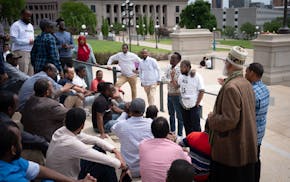Barges are anchored around the old Rock Island Swing Bridge in Inver Grove Heights as it undergoes a unique transformation in the middle of the Mississippi River.
Construction workers from Lametti & Sons of Hugo are turning the old double-decker span into a 670-foot recreational pier for the public.
It was once one of the few bridges on the Mississippi that carried trains on the upper deck and vehicles below.
Set for complete demolition a couple of years ago, the remains of the bridge are now being salvaged in a historic-preservation effort that's drawn national attention. The city of Inver Grove Heights is leading the $2.4 million project.
"It's amazing what they can do with backhoes and barges," said Jake Tabbert, a 21-year-old college student who runs a gas station at River Heights Marina, upriver from the bridge. Boater after boater asks what the bridge is being turned into, Tabbert said.
Most recently known as J.A.R. Bridge (named after previous owners Joan and Al Roman of Chicago, who bought it after rail service ended), the 1,661-foot-long crossing connected the cities of Inver Grove Heights and St. Paul Park for 104 years. It was built in 1895 for the South St. Paul Beltline Railroad to connect stockyards in South St. Paul with main rail lines that ran through St. Paul Park.
The bridge was closed to rail use in 1980, and in 1999, it was closed to road traffic, too.
Memories of the bridge
Ashly Eicher, 22, of Inver Grove Heights, and her friends sat on the deck of the Mississippi Pub on a recent afternoon, watching workers build the new pier.
Eicher recalled girlhood memories of crossing the bridge in her grandpa's car. She said if the entire bridge could not be restored, she's glad at least part of it is being saved.
"It's like one of the only historical sites we have in Inver Grove Heights," Eicher said.
"I personally wish the bridge was still up," said Eicher's friend, Trisha Neisse, 23, of South St. Paul. "It's a lot more useful than this going halfway out into the river."
Rebuilding the old bridge wasn't feasible because it had fallen into such a state of disrepair, according to Eric Carlson, parks and recreation director for Inver Grove Heights.
Also, the swing bridge wasn't high enough to allow barges to pass under it, and it couldn't be left in a closed position to be used as a recreational bridge for bicyclists and pedestrians without staffing it with a worker to open and close it, he said.
Down on the river, Jay Yankovec was gassing up his boat at the marina dock, talking of how he used to take the bridge to get to what was known as Ashland Refinery in the 1990s.
"I used to go over it a lot and pay that 75-cent toll," Yankovec said. "I liked the toll bridge."
Yankovec, 46, of West St. Paul, also wishes the entire bridge could be restored.
"We want to go across," he said, and then joked: "At least put a bar out there."
Salvaging a treasure
For years, officials from Washington and Dakota counties had discussed removing the old bridge, but plans turned urgent in 2008 after a 200-foot section fell onto the river banks on the Washington County side.
Inver Grove Heights stepped in, saying it would cost the city less to restore the usable parts than to demolish the structure. The city secured a $1.3 million federal grant and $100,000 from the Minnesota Historical Society.
Dakota County commissioners kicked in $150,000, and a local fund drive is underway to help pay for the pier.
The project will re-use the Dakota County side of the structure, reconstructing two missing spans. They will connect two others still standing in the river to the shore in Inver Grove Heights.
One new span will be 140 feet long and the other will be 250 feet. They will have wooden decks and be constructed of naturally weathering steel.
Though the pier will play up the natural beauty of the river corridor, area residents and officials know that the structure could become marred by vandals if precautions aren't taken.
Graffiti was a terrible eyesore on the old structure, covering nearly every other foot of the structure, recalled Neisse and Eicher. The old structure wasn't lit up and had become a teen hangout.
Carlson said workers have been removing old graffiti and lead paint from existing spans.
"The project includes security lighting as you approach the recreational pier, and then there will be lighting on the pier itself to try to make sure that you can see people on it when it does get dusk or dark," Carlson said. "Hopefully, that will help deter some unwanted behavior."
The pier will be closed at night, he said, but the hours of operation have yet to be set.
"We hope that by bringing positive attention to the structure, people who use it will be respectful of public property and know that it shouldn't get tagged," he said.
Joy Powell • 952-882-9017

Equal rights, abortion protections move closer to landing on the 2026 ballot

Minnesota Legislature's 2024 session ends in anger and acrimony

Minnesota Legislature approves minimum pay for Uber and Lyft drivers

Two missing after canoes went over Boundary Waters waterfall


